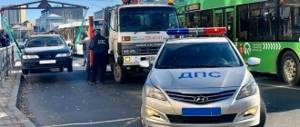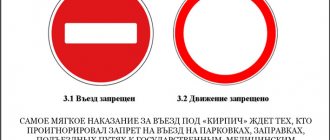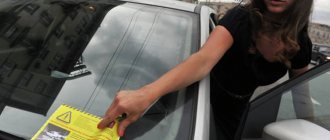Traffic violators can be not only vehicle drivers, but also ordinary pedestrians. Along with motorists, they can be held accountable in accordance with the article of the Code of Administrative Offences. Among the most common offenses committed by pedestrian road users is jaywalking . In this article, we will consider in more detail the amount of the fine for violating the crossing of the road, which falls under this definition, as well as the procedure for bringing to administrative responsibility.
Rules for pedestrians crossing the road.
The rules of the road apply equally to all participants, including pedestrians, with the only difference that the established requirements for them are much smaller. When crossing the roadway, every citizen must follow a number of rules:
- Crossing the road is allowed only in places specially designated for this. In turn, such zones include: overground and underground passages, unregulated and regulated intersections and sections of the road with appropriate zebra markings, places with special road signs.
- It is allowed to cross the roadway along the curb line, as well as the sidewalk in places without signs and markings, if there is no likelihood of causing interference to other traffic participants.
- If there are no markings, then one should cross the road perpendicularly from one edge of the sidewalk to the other.
- At controlled pedestrian crossings, you must wait for the permission signal from the inspector or traffic light;
- Despite the priority of movement along the zebra crossing, when crossing uncontrolled intersections, you should make sure that all traffic stops in a timely manner.
Important:
It is worth noting that drivers are required to give way to pedestrians crossing the crossing in a designated place. Failure to comply with these requirements is a violation of Article 12. 18 of the Code of Administrative Offenses. However, you should not risk your life and health, proving that you are right, and throw yourself under a car.
- Crossing the roadway should be done without creating or provoking emergency situations.
- Movement along the transition is carried out without stopping. The only exceptions are cases of passage of special government vehicles, as well as vehicles that do not have time to stop.
- To avoid accidents, all pedestrian actions must be unambiguous and visible without misleading other road users. In turn, this can be a sudden change in direction of movement, a sudden exit onto the roadway, etc.
- If a pedestrian moves at night outside a populated area, then his clothing should be equipped with reflective stripes or bandages.
- It is prohibited to cross the roadway in places not intended for this purpose.
It is worth noting that vehicles with special light and sound signals have priority in traffic. Therefore, both motorists and pedestrians must let them pass at intersections and crossings.
Traffic Laws
It would be a good idea to find out what the traffic rules say regarding pedestrian traffic. Their interpretation is as follows:
- The transition can be made through ground, underground or overground passages.
- At intersections with traffic lights, you can only cross when the light is green.
- If there is no zebra crossing, then you should cross the road moving perpendicular to the curb, and not diagonally.
- It is important to accurately assess the visibility and presence of vehicles in both directions.
- You must not interfere with cars or provoke emergency situations.
- When crossing the road at night outside the city, you must have reflective items with you.
- If a car with special signals is following along the road, pedestrians are prohibited from crossing the road.
Not every pedestrian knows these rules and, as a result, is very surprised when he is given a fine for crossing the street in the wrong place.
The legislation clearly defines the situations in which it is permitted to cross the road:
- Driving on the street should be in permitted places, sidewalks or along the side of the road;
- It is allowed to cross the road only when the signal is green or with the permission of the traffic controller. Otherwise, it will be considered jaywalking;
- when crossing the road, evaluate factors such as safety, distance and visibility;
- You cannot stop and slow down at the intersection of the roadway without a good reason and interfere with drivers;
- if there are no zebra markings, then crossing a busy section of the road is only allowed at an angle of 90°;
- When approaching a car with special signals on, it is prohibited to cross the road. If a pedestrian begins to cross the street, you should return to the starting point;
- When crossing roads outside populated areas at night, pedestrians must wear clothing with reflective elements.
Crossing the roadway in the wrong place entails a fine and, in rare cases, leads to criminal punishment.
What falls under the crossing in the wrong place?
Jumping is the fact of any crossing of the road in areas without special signs and markings, as well as failure to comply with the rules of one’s own safety while driving through the roadway.
Thus, an offense is committed if the road crossing occurs outside:
1. Ground crossings are regulated and unregulated areas with zebra markings on the road and/or marked with a special sign.
2. Overpass - a structure passing over the highway.
3. Underpass - a tunnel-like structure passing under the road surface.
The most common cases of illegal road crossing include:
- Selecting a site for crossing the roadway far from the designated areas;
- Crossing the road before reaching a pedestrian crossing;
- Ignoring the presence of a crossing, for example, an overpass, and following the road along the carriageway;
- Creating an emergency due to inattention, haste or disregard for the safety of movement.
- Lack of reflective emblems on pedestrian clothing at night.
It is worth noting that an accident involving a vehicle and a pedestrian outside the transition zone does not entail criminal liability for the driver if the accident resulted in serious harm, including death, to the other party. In this case, the citizen driving the car may be held financially liable under the Civil Code, but only on the basis of civil proceedings.
What needs to be done to challenge?
It also happens that citizens are convinced of the illegality of actions committed by law enforcement agencies, and, in their opinion, inspectors fined people for no reason. In such a situation, domestic legislation gives ten days to appeal. Regardless of whether a person understands that jaywalking is an administrative offense or not, it is important to remember the following.
- Already as part of the preparation of documents, the column “Explanations of the violator” must be filled out. There should be something like this wording: “I consider holding the administrator accountable under the article “title of the article” to be unlawful, I do not agree with the guilt.” You must sign your name, indicating that guilt is completely denied.
- A citizen has every right to first familiarize himself with the collected materials not only in court, but also in the process of drawing up a decision.
- The law makes it possible to present personal evidence in the form of witness testimony, information from video cameras located on the territory of nearby buildings.
- You can create your own diagram, simultaneously attaching photos that allow you to get a complete overview of the road. This will help you understand if there is a zebra in sight and so on.
Unfortunately, violators who are faced with bias from traffic police officers do not always successfully defend their position in court. The best solution in this case would be to fully comply with traffic rules and prevent situations in which the actions taken would be regarded as an offense.
At first glance, it seems that a pedestrian should give way to a car, but this applies to crossing the road in an unintended place. An offense may also be registered by a driver if he:
- Does not give way to pedestrians on the roadway, provided there is a zebra crossing.
- Does not slow down, noticing that the vehicle ahead is stopping, and at the same time overtakes it if there is a pedestrian crossing sign.
In practice, when an accident occurs involving a pedestrian and a vehicle, the blame is almost always placed on the driver, and he has to pay a fine in accordance with the Code of Administrative Offenses. This happens because the motorist is considered the owner of a vehicle with increased danger. Pedestrians often take advantage of this because they feel impunity.
In this regard, traffic police officers strengthened control over people crossing the road, which caused a surge in on-the-spot citations for violations.
A fine under the Code of Administrative Offenses for crossing the road in the wrong place.
So, administrative liability for violating a road crossing occurs under articles of the Code of Administrative Offenses No. 12.29, as well as 12.30. In turn, punishment can have the following types:
1. Warning. As a rule, it is given to pedestrians for a first violation that does not result in serious consequences.
2. Fine:
- 500 rubles for crossing the road in the wrong place repeatedly or more times;
- 1,000 rubles for an incorrect crossing that caused interference with transport, as well as an emergency situation. As a rule, for this there must be an evidence base in the form of photos, videos and eyewitness accounts;
- 1,000 - 1,500 rubles , if the actions of a pedestrian led to an accident causing harm to the health or life of at least one of the participants.
However, a similar preferential rule applies to pedestrians on a par with car owners. If the fine is paid within twenty days, then half of the amount specified in the resolution must be paid.
How to pay
Payment of a fine for jaywalking often occurs online. You can check for a fine in the following ways:
- on the State Services portal;
- from traffic police officers;
- on the bailiffs website;
- through the bank application when entering the name of the violator.
A penalty presented for jaywalking can be repaid without leaving your home - on the Public Services portal or through a bank - online.
If you do not pay the fine within two months, the case is transferred to bailiffs, which in the future threatens problems when traveling abroad. At the same time, after transferring the case to the bailiffs, the amount of the fine increases by 2 times and will already amount to 1000 rubles.
You can take advantage of a discount on paying a fine for jaywalking if it is paid off within 20 days from the date of issuance of the administrative resolution. The discount amount is 50%.
Before paying a fine, you need to check whether the decision has really been issued, and, of course, if the pedestrian agrees with it. Otherwise, you can challenge the decision in court.
The inspector cannot draw up a report without the pedestrian noticing; he needs to communicate with the violator, so often there can be no doubt about the existence of a fine. But sometimes you need to look at certain data regarding it. Before you pay a fine for jaywalking, you need to know:
- How much is the fine.
- What amount was it written for?
- Payment receipt number.
This data can be obtained via the Internet using such online services as:
- Website "Traffic Police Fines".
- Online service "Government Services".
- In almost any online banking application. Here you can find out what fine for crossing the road in a prohibited place was issued through the fine search form by the violator’s name.
We invite you to read: Power of attorney for a grandmother to represent the interests of a child in a medical institution: sample 2021
And one more question that may arise is how to pay a fine to a pedestrian. This can be done through the traffic police website, payment terminal or at a bank branch.
For pedestrians, the rule also applies: a 50% discount when paying in the first 20 days from the moment the fine is imposed. If there is an administrative penalty, we pay it as quickly as possible.
Prosecution for crossing the road in the wrong place.
Since crossing the road incorrectly is a violation of traffic rules, the procedure for liability is the same for drivers and pedestrians. The whole process consists of the following stages:
- The fact of violation of traffic rules by a pedestrian is established;
- Measures are taken to ensure administrative violation proceedings;
- Collection of evidence confirming the pedestrian’s guilt;
- An administrative protocol is drawn up.
- The case of the offense is considered, following which a decision is made.
- The decision made can be appealed by the culprit if he has made an appropriate decision.
In turn, stages 1 – 5 are carried out by the traffic police authorities within their competence.
Where to pay a fine for a pedestrian
Payment of a fine for jaywalking can be carried out voluntarily or compulsorily. An attempt to pay the inspector on the spot will be regarded as a bribe, since repayment of penalties is allowed only through a bank or other payment systems.
You are given 60 days to voluntarily pay the sanction. If the money does not reach the budget within this period, the resolution is transferred to the bailiffs for enforcement. Bailiffs can deduct a fine from a citizen’s salary or account.
Appeal against the decision.
Pedestrians have the right to appeal a decision made against them in the following order:
1. Write and send a statement on your behalf to the head of the traffic police department that adopted the resolution, demanding its cancellation;
2. If the application is refused or ignored, then a claim is filed with the court at the location of the inspection;
3. The case is considered in court, taking into account all the evidence presented.
4. A decision is made in favor of the plaintiff or defendant. If the claim is satisfied, the court sends an extract of the decision to the traffic police department. At the same time, the applicant has the right to independently transfer it to the destination address.
5. A resolution is formed that cancels the previous one.
It is worth noting that the decision can be appealed without filing an application with the traffic police.
Legal grounds regulating pedestrian movement on the roadway
The rules of conduct for pedestrian traffic participants are regulated by Chapter 4 of the Traffic Regulations. The regulation specifies all situations when a pedestrian has the right to cross the road. Violations for which the pedestrian is liable are also indicated.
Important aspects of this law:
- Crossing the road on foot is permitted only in underground or above-ground areas provided for this purpose;
- if there are no zones in the pedestrian’s field of vision, it is possible to cross the road on the sidewalk or side of the road;
- in those areas of road intersections where traffic flow regulation is provided, you can cross the roadway only at the appropriate traffic light signal or with the permission of the traffic controller;
- crossing the road outside the permitting marking zone must be carried out at a right angle;
- Before crossing the road, it is necessary to make a correct assessment of the traffic situation, including understanding whether the pedestrian is in the visible zone of the vehicle drivers;
- when crossing a roadway area not intended for this purpose, you must remember that all its areas must be clearly visible and not have obstacles in the form of standing vehicles or buildings blocking the view;
- the pedestrian, before starting to follow the roadway, is obliged to assess the degree of distance of the moving vehicle from him;
- It is unacceptable to interfere with the movement of other pedestrians and drivers by your behavior on the road; it must be remembered that such violations can lead to an accident;
- Inconsistent behavior of a pedestrian when crossing the roadway is prohibited, as it may be misinterpreted by the driver and lead to an emergency;
- a pedestrian who is outside the city must ensure that his clothing contains reflective elements when it gets dark;
- in the presence of vehicles equipped with special signals in the immediate vicinity, the pedestrian participant in the movement must remain in the pedestrian zone or return to it if the movement has already begun.
Unfortunately, many pedestrians are not aware of these traffic regulations. Often citizens learn about the necessary rules of behavior on the roadway only when traffic police officers impose punishment on them.











